
Eucalyptus marginata, commonly known as jarrah, djarraly in Noongar language and historically as Swan River mahogany, is a plant in the myrtle family, Myrtaceae and is endemic to the south-west of Western Australia. It is a tree with rough, fibrous bark, leaves with a distinct midvein, white flowers and relatively large, more or less spherical fruit. Its hard, dense timber is insect resistant although the tree is susceptible to dieback. The timber has been utilised for cabinet-making, flooring and railway sleepers.
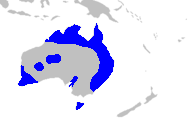
Xanthorrhoea is a genus of about 30 species of flowering plants endemic to Australia. Species are known by the name grass tree.

Phytophthora cinnamomi, also known as cinnamon fungus, is a soil-borne water mould that produces an infection which causes a condition in plants variously called "dieback", "root rot", or, "ink disease".
The ecology of Banksia is the relationships and interactions among the plant genus Banksia and its environment. Banksia has a number of adaptations that have so far enabled the genus to survive despite dry, nutrient-poor soil, low rates of seed set, high rates of seed predation and low rates of seedling survival. These adaptations include proteoid roots and lignotubers; specialised floral structures that attract nectariferous animals and ensure effective pollen transfer; and the release of seed in response to bushfire.

Xanthorrhoea australis, the grass tree, austral grasstree or blackboy, is an Australian plant. It is the most commonly seen species of the genus Xanthorrhoea. Its trunk can grow up to several metres tall and is often branched. In certain Aboriginal languages, it is called bukkup, baggup or kawee.
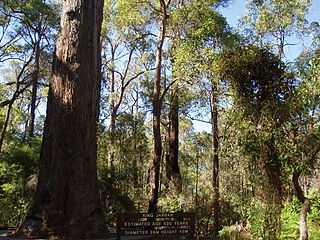
Jarrah Forest, also known as the Southwest Australia woodlands, is an interim Australian bioregion and ecoregion located in the south west of Western Australia. The name of the bioregion refers to the region's dominant plant community, jarrah forest – a tall, open forest in which the dominant overstory tree is jarrah.

Xanthorrhoea preissii, known as balga, is a widespread species of perennial monocot in Southwest Australia.
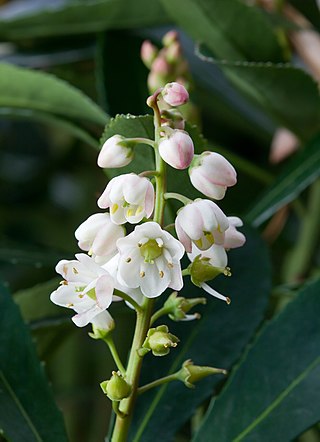
Anopterus glandulosus, commonly known as native laurel or Tasmanian laurel, is a species of shrub or small tree in the family Escalloniaceae. Endemic to south and southwestern Tasmania, A. glandulosus is widespread in the moist understoreys of Tasmanian temperate rainforests and wet sclerophyll forests from sea level to mountainous regions below 1,200 metres (3,937 ft) above sea level.

Isopogon ceratophyllus, commonly known as the horny cone-bush or wild Irishman, is a plant of the family Proteaceae that is endemic to the coast in Victoria, South Australia and on the Furneaux Group of islands in Tasmania. It is a small woody shrub that grows to 100 cm high with prickly foliage. It is extremely sensitive to dieback from the pathogen Phytophthora cinnamomi

Adenanthos meisneri, commonly known as prostrate woollybush, is a species of shrub in the family Proteaceae. It is endemic to the south-west of Western Australia.

Xanthorrhoea fulva is a species of grasstree of the genus Xanthorrhoea native to New South Wales and Queensland. It was previously regarded as a subspecies of Xanthorrhoea resinosa, but reclassified as a species in its own right in 1986.
Calothamnus gracilis is a plant in the myrtle family, Myrtaceae and is endemic to the south-west of Western Australia. It is a spreading shrub with upright foliage, common in heath within its range. It has long, thin leaves and produces dark red flowers at different times of the year, depending partly on rainfall. It is similar to Calothamnus gibbosus but lacks the corky bark on the older branches of that species and its flowers and fruit are not as deeply embedded in the bark.
Darwinia nubigena, commonly known as success bell or red mountain bell, is a species of flowering plant in the family Myrtaceae and is endemic to the south of Western Australia. It is an erect shrub with egg-shaped leaves arranged in opposite pairs, and groups of 4 or 5 pendent red flowers surrounded by larger green and red bracts.
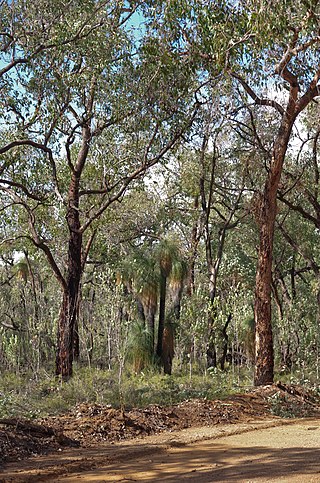
Xanthorrhoea drummondii, commonly known as blackboy, grasstree or Drummond's balga, is a species of grasstree of the genus Xanthorrhoea native to Western Australia.
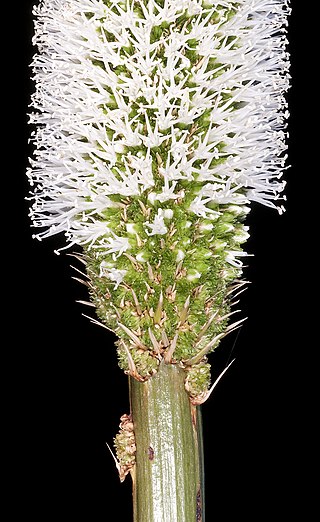
Xanthorrhoea acanthostachya is a species of grasstree of the genus Xanthorrhoea native to Western Australia.
Xanthorrhoea brevistyla is a species of grasstree of the genus Xanthorrhoea native to Western Australia.

Xanthorrhoea brunonis is a species of grasstree of the genus Xanthorrhoea native to Western Australia.
Xanthorrhoea nana, commonly known as dwarf grasstree, is a species of grasstree of the genus Xanthorrhoea native to Western Australia.
Xanthorrhoea platyphylla is a species of grasstree of the genus Xanthorrhoea native to Western Australia.

Xanthorrhoea thorntonii, commonly known as Cundeelee grasstree, Cundeelee blackboy, desert grasstree, yacka or grasstree, is a species of grasstree of the genus Xanthorrhoea native to central Australia. It is known to the Pitjantjatjara people as kata-kultu, kata-puru, ulpa or urara, the Warlpiri people as yurlurnkuru and the Arrernte as lunkere. X. thorntonii is the only grass tree found in Central Australia including the Great Sandy Desert, Great Victoria Desert and MacDonnell Ranges.














